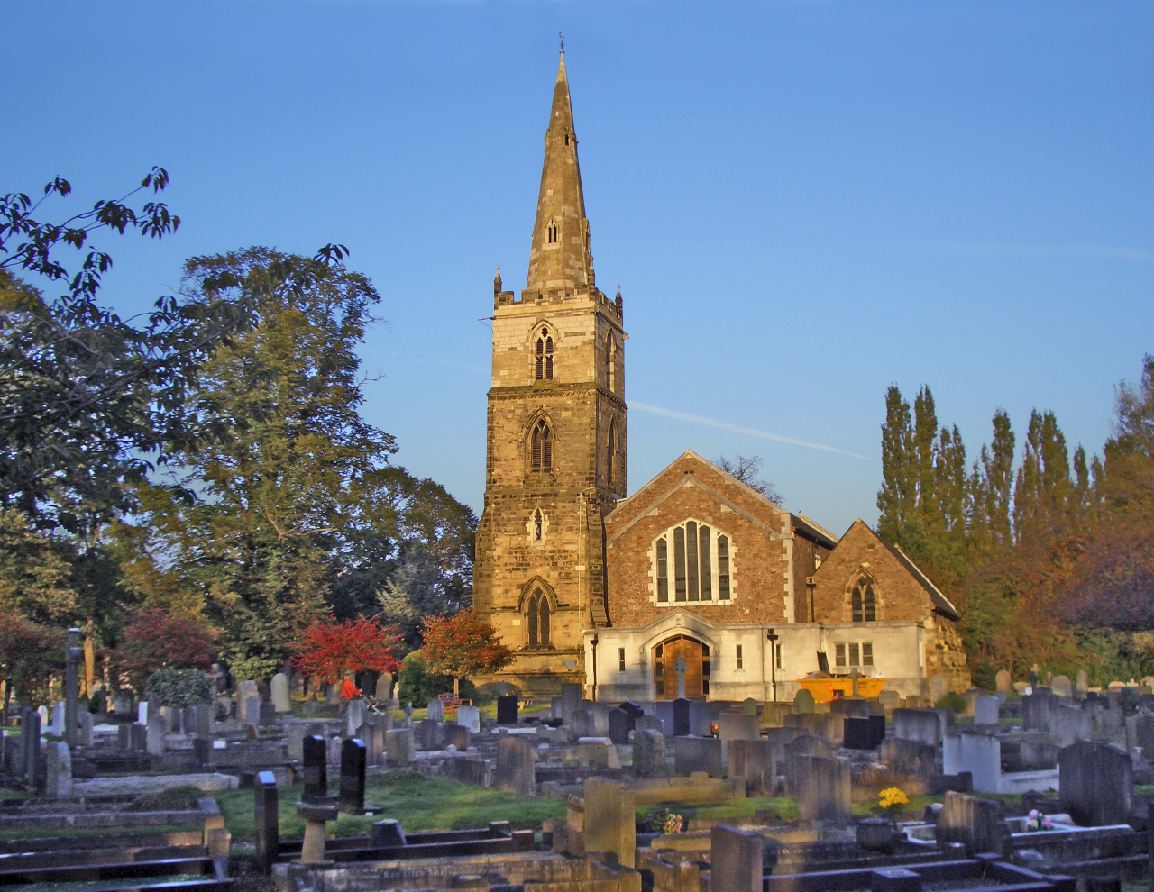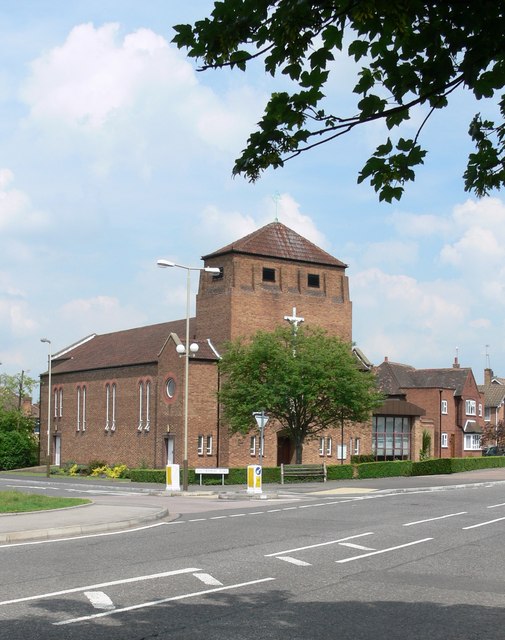St Thomas More's Catholic Church, Leicester on:
[Wikipedia]
[Google]
[Amazon]
 Knighton is a residential suburban area of
Knighton is a residential suburban area of
 The parish of St Thomas More was formed in 1947 and the church was designed in 1948 by the architects Reynolds & Scott, who built a number of parishes in the
The parish of St Thomas More was formed in 1947 and the church was designed in 1948 by the architects Reynolds & Scott, who built a number of parishes in the
Leicester
Leicester ( ) is a city status in the United Kingdom, city, Unitary authorities of England, unitary authority and the county town of Leicestershire in the East Midlands of England. It is the largest settlement in the East Midlands.
The city l ...
, situated between Clarendon Park to the north, Stoneygate
Stoneygate is part of the City of Leicester, England.
Situated on the south-east side of the city some two miles from the centre, Stoneygate is a mainly residential suburb characterised by its large Victorian houses. It straddles the London Roa ...
to the east, Oadby and Wigston to the south and the Saffron Lane estate to the west.
Originally a separate village a couple of miles from Leicester city centre, it became linked to it by the areas known as Stoneygate and Clarendon Park during the Victorian period, due to the demand for housing for those newly employed in industry. It still retains several of the village's original buildings, such as Oram Cottage and the Church of St. Mary Magdalen; the village core is now a conservation area
Protected areas or conservation areas are locations which receive protection because of their recognized natural, ecological or cultural values. There are several kinds of protected areas, which vary by level of protection depending on the ena ...
.
Population
The population at the 2011 census was 16,805. but the Knighton census ward differs significantly from the Knighton neighbourhood area. A portion of Stoneygate is included. The ancient parish had a population of 383 in 1831, rising to over 6,075 by 1891, after the first wave of Leicester's Victorian expansion into the northern part of the parish. Knighton itself saw much building in the 1930s and 1940s with red-brick semi-detached houses. The village as a suburb expanded further in the mid-20th century with the building of the housing estates of West Knighton and South Knighton. These two estates have a mix of housing of the post-war era.History
Knighton was named in the Domesday Book of 1086 (where it is spelled ''Cnihetone'', and gives a picture of a fairly large village of 24 households and substantial farmlands, all under the manorial lordship of the Bishop of Lincoln, who at that time was a Norman cleric named Remigius de Fécamp. It functioned as a civil parish between Leicester andWigston Magna
Wigston, or Wigston Magna, is a town in Leicestershire, England, just south of Leicester on the A5199. It had a population of 32,321 in 2011.
Geography
Wigston is south of the city of Leicester, at the centre of Leicestershire and the Ea ...
, with an identity separate from the town of Leicester until the end of the 19th century. Ecclesiastically, it was a chapelry of St Margaret's Church, Leicester and appears to have been so since before the Norman conquest. Both St Margaret's, Leicester and St Mary Magdelene, Knighton, were held by the Bishop of Lincoln, and from the 13th century St Margaret's was a prebendary church of Lincoln Cathedral, and thus had considerable autonomy compared to Leicester's other ecclesiastical parishes, which were all held by Leicester Abbey. The tithes and glebe lands at Knighton were thus in the hands of the vicar of St Margaret's. Although Knighton Church dates back to at least the 13th century, it was served by a curate, and did not have its own vicar until it was made a separate ecclesiastical parish in 1878.
The medieval parish had four substantial open fields, and the village economy was centred on agricultural activity. Until the Enclosure award of 1756 these four open fields, named Stockwell, Safforn, Goldhill, and the Breach Field, were subdivided into narrow strips that were allocated annually amongst the families in the village. These fields were enclosed in 1756 and divided up permanently between the 14 families that had rights to the land, giving a snapshot of the spread of wealth in the village. were allocated, in proportion to the size of each family's existing rights. The Craddock family, who by this time were the Lords of the Manor, received almost 700 acres. Of the other families, Edward Inge received 260 acres, the Foster and Johnson families each received well over 100 acres, leaving the other 10 families to share 300 acres between them.
Growth of Stoneygate
Knighton retained its agricultural character into the 19th century, whilst Leicester to the north and Wigston to the south were becoming centres of theframework knitting
A stocking frame was a mechanical knitting machine used in the textiles industry. It was invented by William Lee of Calverton near Nottingham in 1589. Its use, known traditionally as framework knitting, was the first major stage in the mechan ...
cottage industry. The first effects of the expansion of Leicester were felt, not in the village itself, but in the area of the parish that became known as Stoneygate. Suburban development had its beginnings in the 1770s and 80s with a substantial private dwelling called Stoneygate House, on what later became Toller Road, followed by the conversion of a farmhouse on the Harborough Turnpike, (now London Road) into a 'gentleman's residence' called The Stoney Gate. By the 1840s there were 10 houses strung along the London Road, occupied by some of Leicester's most prosperous tradesmen and industrialists. The trend of wealthy clients getting a house built for their own use continued up to 1863, by which time there were 32 such spacious mansions. From 1865 the side roads began to be opened up, developed by speculative builders, and a more rapid expansion and infilling got underway.
Clarendon Park
From 1875 the estate that had formerly been The Breach Field, in Knighton's open field days, began to be sold off for development. The density of housing was greater than in Stoneygate, and many streets were laid out with rows of brick terraces, and acquired the name Clarendon Park, apparently as a marketing device. By 1888 Clarendon Park's road layout was substantially complete and built up. Queen's Road and Clarendon Park Road were provided with shops and other community facilities. Large, well-funded churches were rapidly established both in Clarendon Park and to a lesser extent Stoneygate. Among these were St John the Baptist Anglican Church (1885), London Road Congregational (1886), Queen's Road Primitive Methodist (1887), Clarendon Park Road Baptist (1894), St. Michael and All Angels Anglican (1898), Clarendon Park Road Wesleyan Methodist (1901 replacing an 1886 mission hall), Salvation Army (1901) and Stoneygate Baptist (1905).Boundary changes
The historic parish occupied a broad swathe of land on the southern border of Leicester. From Safron lane in the west, it was roughly wide, extending to the Gartree Road in the east.Knighton Park
Knighton Park forms the southern part of the neighbourhood, south of the A563 Palmerston Way. The park was bought from the Craddock-Hartopp trustees by Leicester city council in the late 1930s but wartime prevented its conversion to a public park until 1953. The various compartments and zones within the Park still reflect many of the divisions of the land put in place in 1756 for agricultural improvements when the Knighton open fields were enclosed and subdivided for the first time. Knighton Spinney is a small area of woodland on the north-east side of the Park, in extent, that was declared a Local Nature Reserve in 2003. It was planted as a mix of oak andash
Ash or ashes are the solid remnants of fires. Specifically, ''ash'' refers to all non-aqueous, non- gaseous residues that remain after something burns. In analytical chemistry, to analyse the mineral and metal content of chemical samples, ash ...
trees by Squire Craddock-Hartopp in 1840, as he was concerned about the lack of oaks for shipbuilding. With the shift to iron ships, they were never needed for this purpose, but the spinney was used as a covert for foxhunting. By 1932 the Craddocks could see its wildlife value and covenanted it as a wildlife reserve for all time. It now has a diverse woodland structure, and provides a valuable habitat for spring woodland flowers, birds, mammals and insects.
The park was first awarded the Green Flag Award in 2005. It has a range of amenities, including two play areas, tennis courts, pitch & put (seasonal opening), sensory garden, heath garden. The Wash Brook runs through the park.
St Thomas More's Catholic Church
 The parish of St Thomas More was formed in 1947 and the church was designed in 1948 by the architects Reynolds & Scott, who built a number of parishes in the
The parish of St Thomas More was formed in 1947 and the church was designed in 1948 by the architects Reynolds & Scott, who built a number of parishes in the Diocese of Nottingham
The Diocese of Nottingham, England, is a Roman Catholic diocese of the Latin Rite and a suffragan in the ecclesiastical province of the Metropolitan Diocese of Westminster.
The diocese covers an area of , taking in the English counties of N ...
. The church was designed in a stripped basilican style. The broad west tower is a recognisable local landmark due to its distinctive nature. Whilst there were a number of Catholic churches within Leicester at the time of the church's construction, St Thomas More's was the first to be built to serve the community of Knighton. The foundation stone was laid by Bishop Edward Ellis, Bishop of Nottingham, in 1950. The church was officially opened for use in 1952. The design incorporated a domed baldacchino
A baldachin, or baldaquin (from it, baldacchino), is a canopy of state typically placed over an altar or throne. It had its beginnings as a cloth canopy, but in other cases it is a sturdy, permanent architectural feature, particularly over h ...
over the altar and altar rails, all of which have been removed. At the time of the re-ordering which removed the baldacchino, a parish hall was built adjacent to the church. Stained glass windows along the nave of the church include references to key elements of the Roman Catholic faith, with symbolic representations of Christ's ministry and a number of the sacraments.
In the late 1990s to modernise and to make the church suitable to the reforms implemented during the Second Vatican Council the baldacchino, traditional altar, altar rail and marble lectern were replaced with mosaics implanted into the floor of the sanctuary, a mosaic cross was installed in the confessional and new decorational pieces were placed above the new, unusual octagonal altar.
Notable people
* Henry Knighton: wrote a history of England from the Norman conquest until 1396, the year he died. *Sir William Lindsay Everard: MP, brewer and pioneer aviator. *Clare Hollingworth
Clare Hollingworth (10 October 1911 – 10 January 2017) was an English journalist and author. She was the first war correspondent to report the outbreak of World War II, described as "the scoop of the century". As a rookie reporter for ''The ...
: journalist and first person to alert the world that World War II had started
References
External links
* * {{coord, 52.606, -1.116, region:GB-LCE, display=title Areas of Leicester